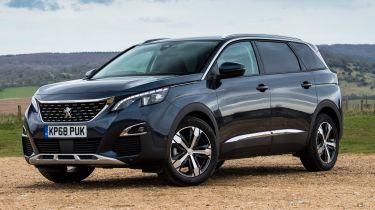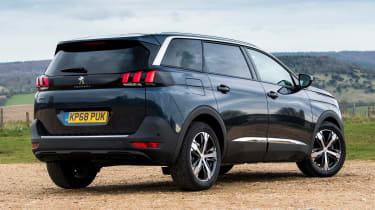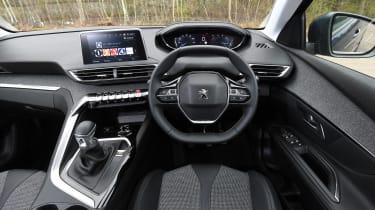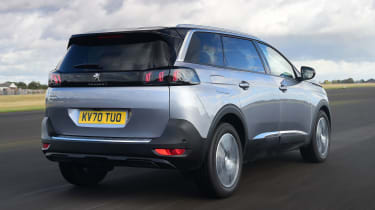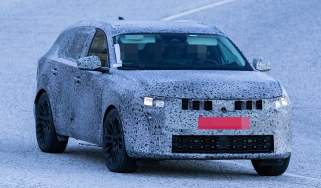Used Peugeot 5008 (Mk2, 2017-2024) buyer's guide: still looks sharp despite its age
A full used buyer’s guide on the Peugeot 5008 covering the 5008 Mk2 that was on sale in the UK between 2017 and 2024
Verdict
If ever you needed proof that car makers can reinvent themselves, the Peugeot 5008 is it. The first generation was okay at several things, but it disappointed in several areas too, most notably its build quality and reliability – long-time Peugeot problems. The 5008 Mk2 comprehensively shook things up with one of the best cabins in the segment in terms of its comfort and usability, plus fit and finish. However, while we’re big fans of the 5008, it was beaten by the SEAT Tarraco and Skoda Kodiaq (in that order) in a group test in 2018. On the other hand, we admitted at the time that a different-spec car might have been higher up the rankings, proving how important it is that you buy the right 5008 for your needs.
Peugeot built its first car in 1889, and for most of the time since then its focus has been on producing affordable, family-friendly vehicles. It was among the first to offer estate cars, hatchbacks, MPVs and SUVs, and although its first attempts at the latter weren’t especially convincing, when the firm decided to turn its 2008, 3008 and 5008 into proper crossovers (the original 3008 and 5008 were more like MPVs), they were far more desirable and much more popular as a result.
We ran a 5008 on our fleet in 2018 and were impressed with its supportive seats, comfortable ride, cavernous interior, user-friendly (and great-sounding) infotainment system, plus its engaging handling. We also loved the quality, and the design inside and out, so could this be the perfect used SUV?
History
The original 5008 (codenamed T8 by Peugeot) arrived in late 2009; its successor (the T87) reached UK showrooms in April 2017, with two petrol engines (1.2 PureTech 130 or 1.6 THP 165 units) and two diesel options. A 1.6 BlueHDi unit came in 100 and 120 forms, while the 2.0 BlueHDi was offered with 150 and 180 choices.
By the end of 2017 there was a 1.5 BlueHDi 130 option, which initially sold alongside the 1.6 BlueHDi engines, but by the end of 2018 the bigger powerplant was dropped. A new range-topping GT Line Premium trim was introduced in February 2018, then in November 2020 a facelifted 5008 arrived with a sharp new look, fresh exterior colour options, extra driver-assistance systems and a digital instrument display now standard across the range. The Mk2 was replaced by the current model in 2024.
Prices
You can buy a used Peugeot 5008 Mk2 for less than £10,000 through our Buy a Car service.
Check the price of a specific Peugeot 5008 with our free car valuation tool...
Which one should I buy?
The diesels offer muscle and economy; the top 2.0 BlueHDi 180 is really strong, but the smaller units are fine too. The 1.2-litre petrol engine is fairly powerful, and while the 1.6 THP has much more urge, it’s quite thirsty.
Kicking off the range is Active trim, which has an eight-inch touchscreen display, rear parking sensors, a DAB radio, dual-zone climate control, automatic headlights and wipers, and 17-inch alloys. Also included are Apple CarPlay and Android Auto.
Move up to an Allure and Peugeot adds front parking sensors and a rear camera, privacy glass, part-synthetic leather trim, nav, voice control and 18-inch alloys. The GT Line comes with a black headlining, and GT Line Premium adds keyless go, heated and massaging front seats, a panoramic glass roof and 19-inch wheels.
Alternatives to the Peugeot 5008
Arguably the closest rival to the 5008 is Peugeot’s own 3008, which offers the same attributes, but in a smaller, five-seat package. If seven seats aren’t essential, the 3008 is well worth a look. If you do need all those seats, the Skoda Kodiaq, VW Tiguan Allspace and SEAT Tarraco should fit the bill thanks to their roomy and practical interiors, efficient engines and decent dynamics.
Another impressive seven-seat SUV is the Kia Sorento, which is good value, well equipped and very reliable, backed up by a seven-year warranty. Related to the Sorento is Hyundai’s Santa Fe, which also impresses, although its cabin isn’t quite as nice and there’s only a five-year warranty. In this company the old Nissan X-Trail is dated; you get a spacious cabin and a stylish design, but some versions have only five seats.
What to look for
Spare wheel
All 5008s with a 2.0 BlueHDi engine have a tyre repair kit in the boot, but every other model gets a space saver spare wheel.
Towing
The 5008 2.0 BlueHDi EAT8 won its class in the 2018 Tow Car Awards, with an 1,800kg towing capacity, but most 5008s are rated at 1,200-1,400kg.
Stop/start
Some owners say keeping the stop/start on can kill 12-volt batteries, and unless the battery is in top condition, the system won’t work properly.
Emissions
If you’re worried about taking your 5008 into clean air zones, you shouldn’t be, because every diesel engine in the range is Euro 6-compliant.
Common faults
There have been quite a few recalls, for a variety of issues, but the core reliability of a well maintained 5008 should be good. We hear of electrical faults, so check functions like the tailgate release, door locks and infotainment system.
Interior
If you want a dashboard that’s different, the 5008 should fit the bill with its imaginative design, small-diameter steering wheel, high-quality materials and user-friendly ergonomics. All 5008s come with seven seats, and cabin space is good, but the third row is best for kids; and headroom is tight in the middle row if the car has a panoramic sunroof.
Carrying capacity is excellent, too; fold the second and third rows flat and you have 2,150 litres at your disposal. That drops to 780 litres with the middle row in use, or 167 litres with the rearmost row also upright.
Running costs
All 5008s have to be serviced every 12 months or 16,000 miles, with a schedule that runs Interim, Main, Interim, Major. Peugeot dealers offer two prices: one for OE components and the other with pattern (Eurorepar) parts. So you can pay £199 or £189 for the Interim, and £249 or £219 for the Main. At a Major service, diesels cost £369 or £309, three-cylinder petrol 5008s are £399 or £339, and cars with a four-cylinder petrol £419 or £369.
The brake fluid needs replacing every two years (£65), while the 1.6 THP and 1.5 BlueHDi engines are chain driven. But the belt on 1.2 PureTech, 1.6 BlueHDi and 2.0 BlueHDi engines needs replacing every 10 years or 112,000 miles at £569 (OE parts), or £449 (Eurorepar).
Recalls
Peugeot has recalled the Mk2 5008 a dozen times so far, the first in October 2017 because of chafing starter motor wiring. Faulty parts that could lead to engine failure led to a recall in December 2017 and two months later there was another campaign, due to potential fuel leaks. There were two recalls in July 2018, one because faulty software could lead to overheating and engine failure, the other because of oil leaks.
Wheels working loose led to a recall in November 2018, then there were three campaigns in 2019. These were due to the wiring loom, diesel particulate filters and poorly secured spare wheels. There were three further recalls in 2020, thanks to poorly secured tow bars, sub-standard software leading to the urea injector getting blocked, and faulty diesel particulate filters.
Driver Power owner satisfaction
Although the 5008 has never appeared in our surveys, the very similar 3008 finished in first place in our 2018 new-car poll, before dropping to seventh the following year, then jumping back up to second in 2020. Just as encouragingly, Peugeot notched up an 11th place (out of 30 entries) in our 2021 Brands survey, beating Volkswagen, Nissan and SEAT, as well as Mercedes, Audi and BMW.
Peugeot 5008: what we said
Extracts from our Peugeot 5008 test drive in October 2023
The Mk2 Peugeot 5008 still looks fresh. It’s been transformed from a frumpy MPV into a sharp-looking large SUV, sporting a fantastic interior, seven-seat versatility, and a remarkably composed and comfortable ride.
The 5008 makes a good case for itself in petrol form, but it’s in mid-spec diesel guise that we think will make the most sense to buyers. It’s gutsy enough to handle a full complement of passengers and their luggage, offers impressive economy, and is reasonably refined. The lack of any electrified plug-in hybrid option might put company car buyers off, but it’s hard to fault as a family car.
Engines, performance and drive
The Peugeot 5008 isn’t as sharp to drive as a Skoda Kodiaq, but this family SUV does deliver lots of comfort. Its softer suspension set-up and long wheelbase mean the car smothers worn tarmac and cattle grids with aplomb. This suppleness doesn’t come at the expense of body control because it keeps movements in check with a refined, fairly plush feel.
However, this suppleness has a downside, because the Peugeot leans over in corners more than rivals such as the SEAT Tarraco. The small steering wheel makes it easy to turn the 5008 too quickly and upset the car’s balance. Still, there’s a good level of grip, given the concessions to comfort.
There are two automatic gearboxes used in the 5008 range, and both are fine options. The eight-speed EAT8 used in the 1.2 PureTech and the 1.5 BlueHDi is a typical slushy automatic. It’s smooth, but doesn’t provide the quick changes of a dual-clutch equipped Kodiaq or Tarraco. The 1.2 Hybrid uses a dual-clutch, although an electric motor inside the gearbox allows it to power the car for short distances under electric power alone. Based on our experience with this engine in the smaller Peugeot 3008, it should be able to switch between electric and engine power without fuss at lower speeds.
There’s no four-wheel drive model, but some versions have ‘mud and snow’ rated tyres with Grip Control – effectively an advanced traction control system that can work on the driven wheels individually to maximise traction.
0-62mph and top speed
The 5008 engine line-up is similar to that in the 3008, with a 1.2 PureTech 130 petrol, a 134bhp 1.2 Hybrid, and a 1.5 BlueHDi 130 diesel.
A big, seven-seat SUV with a 1.2-litre three-cylinder petrol engine might sound like a recipe for slow progress, but the unit’s turbocharger helps to deliver maximum torque of 230Nm from just 1,750rpm, which means the 5008 serves up some pretty decent performance. It’ll accelerate from 0-62mph in a reasonable 10.2 seconds. The extra power of the 134bhp 1.2-litre Hybrid can’t negate the extra 120kg of weight from the hybrid system and batteries, so it takes a little longer to complete the same sprint in 10.4 seconds.
Despite the 1.5 BlueHDi diesel having the same power as the 1.2 PureTech (128bhp) and a bit more torque at 300Nm, it’s the slowest of the 5008 range from 0-62mph, taking 11.8 seconds.
MPG and CO2
If fuel economy is your priority, then the Peugeot 5008 for you is the 1.5 BlueHDi 130 diesel because it's the most economical of the lot, with an official WLTP economy figure of 54.1mpg.
The 1.2 Hybrid is almost as economical at 53.3mpg. We saw 45mpg out of a 3008 equipped with this engine, so we’d expect the larger 5008 to get at least 40mpg in the real world, maybe even more if you mostly drive in town and can utilise its electric running as much as possible. We expect the 5008 to be more economical than the equivalent SEAT Tarraco and Skoda Kodiaq, because both have worse official figures.
If you’re on a budget and have to go for pure petrol power, the 1.2 PureTech 130 option is a decent pick. Its official figure is 46.4mpg, which should translate into high-30s in normal driving. Besides, the 1.2 Hybrid costs an additional £1300 over the base 1.2, which is a fair amount of fuel over a typical three-year ownership period, so you’ll need to work out if the extra fuel economy of the 1.2 Hybrid is worth paying extra for in the long run – especially if you don’t cover many miles.
The 1.2 Hybrid’s lower emissions will be useful to company car drivers. It has the lowest emissions of any 5008 at 128g/km, making it several tax brackets lower than the 149g/km 1.2 PureTech. The diesel sits somewhere in between at 131g/km.
Interior design and technology
This second-generation 5008 is radically different from its predecessor, with Peugeot repositioning the car as a full-sized seven-seat SUV to meet the growing demand from car buyers.
As part of that transition, the car has moved to the scalable EMP2 platform that underpins the smaller 3008 and cars from sister brand Citroen, such as the C5 Aircross.
The upright grille, detailed headlights and tail lights, the steep windscreen, raised ride height and hidden C-pillars all give the 5008 a distinctive look, and it’s a similar design to the closely related 3008. Cars like the Skoda Kodiaq have a more traditional look, but the 5008 certainly has a distinctive style, and a facelift in 2020 brought further stylistic tweaks to help freshen things up.
On the inside, it’s all good news, as the 5008 has the same high-quality interior as the 3008. The dashboard wraps around the driver, incorporating Peugeot’s infotainment system – an 8.0-inch touchscreen for entry Active versions and a larger 10-inch screen for all other specifications.
The small steering wheel and high-mounted instrument cluster remain, and you get Peugeot’s latest 'i-Cockpit' display, with a 12.3-inch digital screen behind the wheel. Like Audi’s Virtual Cockpit, you can change the layout of the dials, choose what is displayed (and how) or show the sat-nav instructions in front of you if you have an Allure trim model or above.
Apart from some lower-quality materials on the bottom of door cards and the fiddly touchscreen controls for the air-con, the 5008’s interior is among the best in its class. It’s great-looking yet functional. What more could you ask for in a seven-seater car?
Sat-nav, stereo and infotainment
Peugeot’s 12.3-inch dash display and central infotainment touchscreen look snazzy, and all models get Apple CarPlay and Android Auto. Mid-range Allure trim upwards features sat-nav with six months of live updates, providing up-to-the-minute traffic info, local search and weather forecasts.
The facelifted 5008 introduced a larger 10-inch touchscreen – the previous eight-inch unit is now only fitted to base Active trim. The new setup uses much of the same interface, but the screen is larger and has sharper resolution. It’s fairly responsive, but doesn’t load as rapidly as we'd like.
We feel the 5008’s setup is let down by Peugeot’s resistance to using physical climate controls. Adding large panels on either side of the screen to display temperature settings seems like a poor solution. These panels can never be minimised, reducing the size of the rear-view camera display so that it isn’t as clear as it could be. It makes the system feel cheap in an otherwise special cabin. There’s a USB socket in the front, but middle-row passengers only get an extra pair in GT trim.
Practicality, comfort and boot space
The Peugeot 5008 is a seven-seater, so if you only need five seats, you can save some money by opting for the cheaper Peugeot 3008. There’s enough room for five adults to ride comfortably, and a further two can fit in the third row on shorter trips, similar to the amount of room you’ll find in a Skoda Kodiaq.
The 5008 certainly isn’t the best for visibility, as the exterior design has resulted in a lot of rearward blind spots. To that end, you may want to consider the top-spec GT because it comes with blind spot monitoring to warn of approaching traffic along your flank. The rear window is also small and feels far away, so the 5008 isn’t the easiest car of its type to park, as we found during our long-term ownership of one. You’ll rely on the standard rear parking sensors and cameras to miss hitting things when backing up.
At least the driving position is good, as you can see the dials over the top of the steering wheel, unlike the i-Cockpit set-up in some older Peugeot models. It’s comfortable to sit in thanks to the quality seats, and forward visibility is good. Every 5008 has LED headlights as standard, with Allure trim and above adding automatic high beam assist to help illuminate the road ahead better when there aren’t cars ahead of you.
Size
The 5008 is just over 4,641mm long and 1,844mm wide (2,098mm including mirrors), which means it’s a little smaller than the Kodiaq, and it’s slightly lower, too, at 1,646mm. The Peugeot’s wheelbase is longer than the Skoda’s, at 2,840mm, although legroom in both is plentiful. The Skoda has more headroom in the back, especially if you have a 5008 with a panoramic sunroof.
Leg room, head room & passenger space
The middle row sets the 5008 apart from its closest rivals because there are three individual seats, all with Isofix child seat mountings, and they slide and recline for maximum comfort. Thanks to the 5008’s long wheelbase and flat floor, there’s a huge amount of knee room. We would prefer a bit more give in the hard seat base over longer journeys.
The amount of headroom is good, too, although the panoramic roof (standard on GT Line Premium) robs middle-seat passengers of some space.
The third row is more accessible than the seven-seat Kodiaq, because the middle row pushes further forwards. The rearmost seats are primarily designed for kids, but adults can sit there as long as the row in front is slid forward. Both chairs fold into the floor when not in use, and are covered by lift-up panels that mean you can slide longer items in the back much more easily, plus the second-row seats fold flat.
If you need more under-floor storage, the seats can be removed.
Boot Space
The 5008 has only 166 litres of boot space in the back of the with the third row up. A Kodiaq has a little more boot space with all seats up, while a Nissan X-Trail is pretty pokey.
With the third row of seats folded down the Peugeot 5008 provides 952 litres of boot space, much more than the Kodiaq’s 720 litres. You can also take the rear seats out completely (they are comparatively light compared to some rivals) which means you’ve got a massive 1,060 litres of space.
Fold the second row of seats down, and the 5008 has 2,150 litres of space, which also beats the Kodiaq’s 2,065-litre capacity. It’s impressive and means the 5008 is one of the roomiest cars in its class.
Come and join our WhatsApp channel for the latest car news and reviews...

